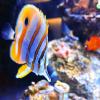Do the following.
1) Check your water parameters. If it's not normal, change water.
2) Stop adding fish. Adding too many fish at once can cause an overwhelming outbreak as more fishes have less resistance to the strain of ich in your tank. The more vulnerable hosts for ich, the more quickly ich can populate and reach a level which can kill your fishes. If you do not practice good quarantine, your best bet is only add a fish every 2 weeks, although I would opt for 1 fish a month. This gives the new fish to build immunity. Fishes that have built resistance to ich can "disarm" ich parasites when the parasites attach to them. You need to have a balance. Immune fishes way more than non-immune fishes.
3) Add It's Clear. Natural water clarifier that improves water quality and does bind to ich. Battles Ich the natural way. This is NOT medication, it's a natural biodegradable polymer called chitosan.
4) Feed medicated food like Dr G's Anti-parasitic RX. This contains quinine which is very effective with common parasites like ich, velvet, brook, etc. This treats your fish and not your entire tank, does not wreck havoc to your tank biological filter.
5) Stop adding fish till symptoms subside.
6) Do not add medication to your tank.






